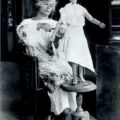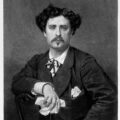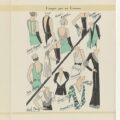Madeleine Vionnet-Haute Couture
January 7, 2015“When a woman smiles, her dress should smile with her” – Madeleine Vionnet
Vionnet couture
It’s hard to know where the red carpet would be without a hugely creative and determined entrepreneur called Madeleine Vionnet.
Of course, first and foremost, she was a designer, but Madeleine Vionnet, born in 1876, was just so determined.
She left school at the age of 12, not unusual for the time of course, as she was from a poor family. She was then apprenticed to a seamstress, but by 16 was in England – a somewhat more unusual move for a penniless French girl.
At the age of 20, the by now accomplished needlewoman was put in charge of the seamstresses at the London branch of Paquin, and came back to Paris a few years later to join Callot Souers, which was one of the most important fashion houses of the day. Madeleine Vionnet rose to become to chief assistant to the head of artistic design.
It was this designer, who was called Marie Callot Gerber and was the eldest of the Callot Sisters, who she felt really made her learn how to be a stand out designer. “It was she who taught me how to make a Rolls Royce – without her I would have made only Fords”.
Madeleine Vionnet and Jacques Doucet
In 1907 she was headhunted, his time in order to entirely rejuvenate the image of couturier Jacques Doucet. Madeleine Vionnet made bold moves. She designed dresses which needed no corsets, and she raised hemlines, making radically modern statements.
At this period in history, dress reformers had been clamouring for just this: clothes that let women cast aside their stays, move freely, play sports, dance to their heart’s content. Nevertheless, clients and sales staff were horrified. So, in 1912 Madeleine Vionnet started her own business, offering her own designs to her own clients – but no, even though they were looking for something new, something less restrictive, she was still ahead of her time. In fact, her business didn’t really lift off until after the First World War. Perhaps people were more inclined to appreciate her pared-down ideas after the stringencies of wartime.
Subdued colours
Certainly, next to an opulent Paul Poiret design, for example, they may have seemed plain. The outfits Madeleine Vionnet made were usually in white, or subdued colours, and lacked the high decoration of pre-war Orientalism.
But her yards of heavy silk satins flowing around the body and highlighting a woman’s curves to their best advantage may have had minimal colour and trimmings, but were hardly minimalist. The luxurious fabric was the opposite of severe, and certainly not utilitarian.
Despite the lack of hard lines I almost want to liken her work to architecture, – Madeleine Vionnet was a gifted mathematician and used that knowledge to calculate the geometry involved in her designs. Or perhaps sculpture – the dresses were conceptualized in three dimensions, as the designer draped fabric on a half-sized wooden mannequin. The more usual way, then as now, was by drawing sketches.
Bias cutting
Madeleine Vionnet also invented a revolutionary way of cutting her gowns on the bias. The technique of bias cutting already existed, but it was used minimally, on small parts of clothing such as collars to give them enough stretch to fit properly.
Nobody created whole gowns this way, perhaps in part because it was so extremely expensive – bias cutting means you are cutting on the diagonal of a fabric’s grain, and you can’t fit many pattern pieces side by side this way. It means you need many more yards of fabric than you would normally.
Madeleine Vionnet – crêpe rosalba
In fact, eventually Madeleine Vionnet was having fabric specially woven for her – two yards wider than normal. And not only specially woven – in 1918 her main supplier actually invented a fabric especially for her: an early synthetic called crêpe rosalba, perfect for her needs.
Degrees of complexity
Cutting on the bias causes a fabric that is normally without any elasticity to stretch and drape to quite an astonishing degree – and because this slippery, heavy silk Madeleine Vionnet was using now became pliable, and prone to distortions both desirable and undesirable (stretching and flowing over the bust: good. Stretching and wavering at the hem – a disaster) you can see that she needed to be both a very good seamstress, to control the unruly silk, and an even better designer, to cut seams accurately in the first place.
Because of this complexity, however, once the dress was off many women found themselves gazing at it perplexed. They had to call the designer for instructions on how to get it back on again.
Another reason why Madeleine Vionnet may have been the first to create gowns in this way is that previously, with corsets and petticoats underneath, the top layer of your outfit needed to be stiffly structured too. Imagine draping a Grecian Goddess gown over all the ruffles of Edwardian underwear; you’d be able to see every seam of your corset.
In fact, you’d struggle to hide even the smoothest of seam free modern t-shirt bras under one – so all that pesky underwear had to go. All of it. Madeleine Vionnet really was a devotee of the natural body and drew inspiration from lightly draped classical Greek and Roman statues which as we know show no visible panty lines.
When a woman smiles, her dress should smile with her
Madeleine Vionnet intended that women should move freely and easily, yet still look elegant and beautiful. This is what she means by the quote, “When a woman smiles, her dress should smile with her”. Her dresses were very responsive to the wearer, and she ensured that any decoration they did have was carefully applied along seams or at strategic points so that the elasticity and movement of the garment was never interrupted.
So after the war, fashionable society finally caught up with her, and for twenty years her house was a roaring success with society women and film stars.
Madeleine Vionnet – Ahead of her time
At her height, Madeleine Vionnet was employing 1,000 people in her business, and she offered them not just tea breaks and paid holidays, but doctors, dentists, and even an on-site travel agents who dealt with all her staff’s holiday plans for them. Nothing even approaching this was enshrined in law at that date.
Madeleine Vionnet’s signature style
Although Madeleine Vionnet’s signature style, (and the hundreds of copies of it that sprang up) became the epitome of 30’s Hollywood glamour, in 1939 her business closed. And though she lived until 1975, and was still interested in fashion right up to her death at the age of 98, she never started another venture. Perhaps she felt that things had moved on, and her ideas wouldn’t fit amongst the renewed enthusiasm for corsetry and structured clothing that re-emerged in the 40s and 50s.
Personally, I think Madeleine Vionnet would have adored lycra, and found the possibilities of laser cutting endless. I like to imagine her dressing the little wooden mannequin in small scraps of jersey and neoprene, frowning thoughtfully as she laser welds them together in a gorgeous creation for the screen stars of today.
Kate Winslet in Valentino dress at Oscars 2007
Even the woman in the Vionnet logo looks unsure how to put on her new Vionnet dress- Madeleine Vionnet logo by Ernesto Thayaht, 1922
Vionnet gowns
Les Robes de Paul Poiret, 1908
A 1937 gown. Photograph by Man Ray
Madeleine Vionnet and her mannequin, about 1920
This diagram shows the precise mathematical geometry behind the flowing lines
illustration by Thayaht, 1922
Magically simple – An autumn winter 1920 design
The complicated structure of the gowns left clients baffled
Inspired by Grecian Nymphs – a 1931 design
Vionnet gown
Claudette Colbert as Cleopatra in Vionnet dress
Claudette Colbert in Cleopatra, gown designed by Vionnet
And here’s the sumptuous gown itself
And another image of that, because why not.














